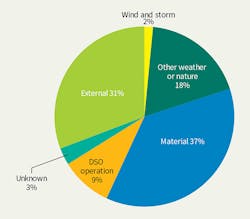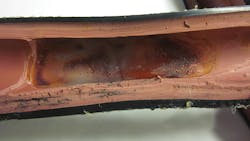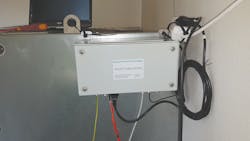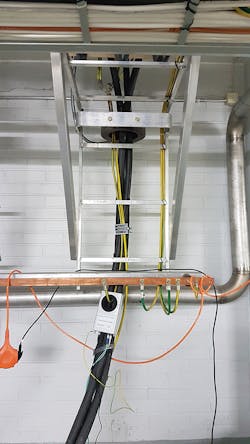Helsinki Restores High Reliability
Helen Electricity Network Ltd. is the distribution system operator (DSO) for Helsinki, supplying some 380,000 customers in Finland’s capital. With government offices and business headquarters, customer demand for a reliable, quality supply is high. The total length of the distribution network is about 6300 km (3915 miles), including a 20-kV medium-voltage (MV) network that is 1600 km (994 miles). Currently, the MV network comprises 99.7% underground cables that supply the city’s peak demand of 830 MW.
Historically, Helen had high-reliability levels; however, at the turn of the 21st century, the annual system average interruption frequency index (SAIFI) started to exhibit high variations. For example, in 2007-2008, the SAIFI value was more than 15 minutes, which prompted Helen to respond by launching a program in 2008 to halve that value by 2015. The program included six development tracks ranging from the commissioning of new high-voltage (HV)/MV substations, refurbishing the secondary system of the existing MV/LV substations, undergrounding the existing MV overhead lines, distribution automation, MV earth-fault compensation, fault analysis and staff training, all of which had to be economically feasible.
As a result of the adverse fault statistics on the MV underground cable network, the utility initiated a study on the health and condition of the MV network to identify the fault causes and support a larger reliability project in Helsinki.
Cable Fault Causes
Fault interruption statistics show about 70% to 80% of the interruptions in European countries on average are caused by failures in the MV networks. Life-cycle analyses of electric power systems often reveal a phenomenon called the bathtub curve. The curve represents the idea that the lifetime of devices can be viewed as comprised of three distinct periods: an early-failure period, a useful-life period with stable failure rates and a wear-out period, where the failure rate increases over time.
Failures in a MV underground cable without an external factor are, in many cases, the consequences of partial discharges (PD) in the insulation evolving into faults. These faults can be prevented or mitigated either by quality requirements and quality monitoring in the procurement and installation phase, or by condition monitoring of the existing MV cables and cable accessories.
The failure rate of network components increases when the age of the component is nearing the expected lifetime of the component, thus forming the rising end of the failure-rate curve. Distribution utilities carry out long-term replacement investment plans to mitigate this effect. However, focusing on the initial phase of the bathtub curve is mutually important—that is, mitigating the effects causing MV cable network faults that occur soon after commissioning. For example, MV cables and cable accessories are prone to having significant infant mortality rates.
Utilities can influence the quality and reliability of a newly commissioned MV cable network in several ways:
• Type and quality requirements of MV cables and cable accessories
• Commissioning and product acceptance of cables and cable accessories
• Quality of installation, especially the quality of workmanship on cable accessories
• Handling the cables and quality of excavation when installing cables.
• Cable testing and in-service condition monitoring
• Asset management during the lifetime of cables, especially educating third-party excavation staff.
Network Fault Study
In 2010, there were twice as many faults on Helsinki’s MV network than in an average year. One reason for this was that a fault had not occurred in this area for years. The first faults stressed the network’s insulation, which led to additional faults. Fault statistics on the MV network showed the two major causes of faults were either material related or external. The faults recorded as material faults included both material faults and faults that were the result of installation faults on the aging MV cables.
The faults statistics from 2004-2010 showed how the faults were distributed between MV cables and cable accessories, with most faults located either in cable joints or the terminations. Over time, Helsinki’s MV network has become fragmented with numerous joints, thus forming a potential risk for additional failures.
Similarly, in a U.S. cable accessory failure-rate study, it was concluded cable accessories have a significant infant mortality rate, with recently installed cable accessories accounting for 20% of accessory-related failures. Poor workmanship was identified as the primary cause of failures, representing almost 50% of total failures. These issues emphasize the importance of good installation quality of cable accessories. As a result, Helen decided improved training would be one of the most cost-effective means to improve MV cable network performance.
In addition to studying the fault distribution between MV cables and cable accessories, the fault rates of different cables, joints and terminal types also were examined. The study revealed striking differences in the fault rates of different MV cable types. Aging oil-paper-type cables had about five times more faults per unit length than newer cross-linked polyethylene-insulated (XLPE) cables. This finding is in line with the Scandinavian fault statistics, where failures detected generally are four times to five times more likely to occur in oil-paper-insulated cables than XLPE-insulated cables.
Network development also was examined to identify when the oldest cables in service would exceed their estimated maximum economical lifetime—using the existing replacement rate as a basis—thereby increasing the overall average asset age of the MV network cables annually. This result prompted the DSO to increase its investment to accelerate the program for replacing aging oil-paper-insulated cables.
Polymeric-Insulated Cables
In 1988, Helen began installing a new 20-kV XLPE-insulated MV cable (AHXAMK-W type) compliant with the European Committee for Electrotechnical Standardization (CENELEC) HD 620 S2:2010 Part 10 Section F and International Electrotechnical Commission (IEC) 60502-2 standards. The cable’s watertight construction provides both vertical and horizontal water tightness. Also, a tape layer of the cable expands with water, which forms a barrier to prevent longitudinal water propagation. The primary function of the aluminum-laminate layer is the tough protection that provides the water tightness in the vertical direction.
Most defects experienced since distribution utilities introduced the use of polymeric-insulated MV cable are electrical degradation from PD, electrical trees and water trees. However, Helen has not experienced water tree problems.
The utility selects 20-kV AHXAMK-W cable from several manufacturers for installation on the Helsinki MV cable network. It specifies all new products be subjected to the following rigorous acceptance procedure:
• Test certificates must be obtained for the relevant standards.
• Current specifications of the aluminum-laminate ground joint for cable accessories must be at least equal to that of the aluminum-laminate layer for cable.
• Joints must have accepted standard impact test results for mechanical resistance.
• Test installations must be organized on the contractor’s premises and contractors must receive training in installation procedures.
Helen has a material technology group responsible for monitoring all design, construction, maintenance and life-cycle issues. Following MV cable selection and installation, the new manufacturer information is entered on the asset database in Helen’s geographical network information system (NIS). This data provides valuable backup assistance should any problems arise with a new product.
The majority of Helen’s MV cable installations are performed by approved contractors with long-term contracts that extend from three years to five years. Quality cable installation standards is one evaluation criteria included in the request for tenders, and contractors are valued based on their response to this requirement.
The contracts include quality in-centives whereby contractors are rewarded for good quality and, alternatively, subject to penalties for inadequate quality. Helen specifies all MV cables be installed in plastic pipes to comply with requirements in joint street infrastructure construction and minimize the risk of third-party damage during street work excavations.
As a result of the MV cable study, Helen initiated the following actions:
• Increased investment in the replacement of aging MV cables so the program could be accelerated, starting with the oldest oil-paper cables that have the highest fault rates
• Started examining the installation quality of relatively new (zero years to five years) MV joints and terminations arising from temporary network installations as well as began taking off-line PD measurements as part of the standard MV network construction and commissioning test process
• Developed and introduced on-site auditing procedures to identify potential future faults
• Actively engaged and participated in a research project on on-line cable monitoring.
Replacement of Oil-Paper Cables
In a Finnish research study (KaLifi), the lifetime of different types of MV cables were examined and estimated. Based on findings from this study and Helen’s MV cable study, which identified high fault rates on aging oil-paper-insulated cables, a lifetime of 60 years was set for Helen’s MV cables.
The accelerated program to replace aging oil-paper-insulated MV cables in Helen has resulted in a reduction of more than 50% in fault rates from 2011-2017.
Installation Quality
Examining the installation quality of relatively new MV joints and terminals from temporary network installations was conducted in cooperation with a cable accessory manufacturer representative. The findings revealed installation faults in some joints and terminations as a result of inadequate heating being used. This resulted in both training the contractor’s personnel to achieve first-grade workmanship on cable joints and terminations installations as well as using new types of cable accessories that could shrink without the use of heat.
Practical training on the cold-shrink joints and terminals was completed under the supervision of the manufacturer’s experts. Now, for joints and terminations, both heat-shrink and cold-shrink technologies are accepted, provided they fulfill the procurement requirements.
To enhance the quality of new installation, contractors now are required to photograph the different phases of cable and cable accessory installations. This is viewed as a means for enhanced self-supervision of the installation quality. Also, a new app, called Quentic, was deployed to help fulfill this requirement as contractors can take photographs in the field with mobile phones and attach them directly to project documentation.
Partial Discharge Measurements
Now included in all of Helen’s new cable installation contracts is an obligation to measure off-line PD on all MV cable installations as a final guarantee of first-grade installation quality. The off-line PD measurements taken on the existing MV cable network have been completed successfully on connections consisting of both MV cables and MV switchgear.
The findings from these measurements have shown the condition of MV cable circuits with multiple cable types is in a weaker condition on average than cable sections comprising one type of cable. However, in circuits consisting only of XLPE-type cables, the joints and terminations often exhibit more evidence of deterioration than the cable.
Earth-Fault Current
As a part of the larger reliability improvement project in Helsinki, Helen has taken into operation the compensation of the earth-fault current in the 20-kV network. The compensation mitigates the earth-fault current so electricity supply can be maintained, thus avoiding customer interruptions. However, during sustained single-phase earth faults, the voltage of the sound phases can reach the phase-to-phase voltage. This creates stress on the MV network and a risk for multipole failures.
To mitigate possible multipole failures, PD measurements were taken during the testing phase of the earth-fault current compensation project, but only a few increased levels of PD were recorded. The extended PD measurements were taken on the networks supplied by two HV/MV primary substations, but—because the measurements revealed the MV networks were in good condition—Helen discontinued the program. The commissioning of the earth-fault current compensation continued without gathering separate PD measurements.
Audits
The procedures for auditing external failures have been developed and every cable fault caused by excavation work is examined and discussed with the contractor, to identify the fault cause and action required to avoid repetition. For larger external building or street works projects, Helen contacts building contractors in advance to advise and emphasize the importance and hazards associated with the existing cable network.
The precautions required when planning a work near electrical cables and guidance on how to work near the underground cable network are now included in the metropolitan-area excavation course, which is mandatory for excavation contractors in Helsinki.
On-Line Monitoring
One disadvantage of off-line PD measurements is this method requires deenergization of a section of the MV network. There are methods to measure PD on-line, and this technology has advanced so rapidly there are now commercial solutions and services available. On-line PD measurements enable condition monitoring of the MV network assets, providing valuable information for life-cycle planning. Helen has started an on-line PD measurement research project, renting on-line PD measuring units and a monitoring service called Smart Cable Guard from DNV. The devices can either measure in fixed places on the network or be moved to different locations to cover a wider area of the MV cable network.
Detection of a potential fault before it occurs can prevent an interruption to supplies and damage to customers’ equipment. On-line PD measuring units from DNV were installed in 2017 on the MV network and, if the unit detects alarming discharges, the monitoring service sends information to the control centre. This is one practical example of using Internet of Things.
The monitoring system consists of two parts: the actual control unit (CU) and the sensor. The sensors are installed around the earth grounding at the cable terminations in a primary or secondary substation. The functionality requires control units and sensors at each end of the measured section of the MV network. This Smart Cable Guard system is now measuring 11 MV network connections in Helsinki.
Cost-Effective Improvement
Examination and remedial action on the quality as well as condition of materials and installations has resulted in a reduction of MV network cable faults in Helsinki. The recorded failure rate in the MV cable network now is only 0.9 faults per 100 km (62.5 miles), very low compared to published international fault statistics. The faults in the newly installed parts of the MV cable network also have been mitigated successfully.
Most of this improvement came from changes in process by the utility and service providers, involving only minor costs. This highlights the cost effectiveness of training to achieve excellent workmanship and quality in the installation of MV cable accessories, deemed to be among the most inexpensive ways to improve the reliability of supply.
Commercial on-line MV cable network monitoring systems then can help in the next steps of prioritizing investment to improve network reliability.
For more information:
DNV | www.dnvgl.com
Helen | www.helen.fi
Quentic | www.quentic.com
About the Author
Osmo Siirto
Osmo Siirto, Dr.Sc., is a director at Helen Electricity Network Ltd. in Helsinki, Finland. Siirto is responsible for regulation and risk management. He has many years of experience on the electric grid, including asset management and network operation.
Jukka Vepsäläinen
Jukka Vepsäläinen, M.Sc., is head of maintenance at Helen Electricity Network Ltd. in Helsinki, Finland. Vepsäläinen is responsible for substations, transmission and distribution networks. He has more than 10 years of experience in electrical network maintenance and operation.
Aki Hämäläinen
Aki Hämäläinen, M.Sc., is head of general and life-cycle planning at Helen Electricity Network Ltd. in Helsinki, Finland. Hämäläinen is responsible for substations, transmission and distribution networks. He has many years of experience in electrical network asset management and network planning.
Mika Loukkalahti
Mika Loukkalahti, M.Sc., is head of principle planning at Helen Electricity Network Ltd. in Helsinki, Finland. Loukkalahti is responsible for principle and system-level planning and specification of the electrical network. He has many years of experience in system-level planning, substation automation and protection. He also has been an active member of several CIGRÉ B5 working groups on substation automation.





